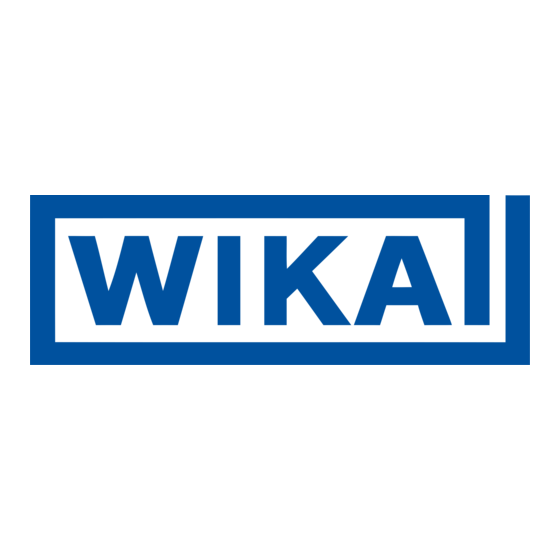
Advertisement
Quick Links
Operating
instructions
Pressure gauges
Examples:
Model 432.56,
overpressure safety
up to 100 bar
Model 213.40
Notes per current pressure equipment directive
The pressure gauges are defined as "pressure
„
accessories"
The volume of the "pressure-bearing housings" of
„
WIKA pressure gauges is < 0.1 L
The pressure gauges carry CE marking for fluid
„
group 1 per annex II, diagram 1 when their permis-
sible working pressure is > 200 bar
Instruments that do not carry the mark are manufactured
per article 4, paragraph 3 "sound engineering practice".
Applicable standards (depending on model)
EN 837-1
Bourdon tube pressure gauges, dimensions,
metrology, requirements and testing
EN 837-2
Selection and installation recommendations
for pressure gauges
EN 837-3
Diaphragm and capsule pressure gauges,
dimensions, metrology, requirements and
testing
Specifications: See data sheet at www.wika.de
Subject to technical modifications.
© WIKA Alexander Wiegand SE & Co. KG 2009
WIKA Alexander Wiegand SE & Co. KG
Alexander-Wiegand-Straße 30
63911 Klingenberg/Germany
Tel.
+49 9372 132-0
Fax
+49 9372 132-406
info@wika.de
www.wika.de
1. Safety
EN
suitable wetted material (corrosion) for the specific
measuring conditions. In order to guarantee the
measurement accuracy and long-term stability
specified, the corresponding load limits must be
observed.
Only qualified persons authorised by the plant
manager are permitted to install, maintain and
service the pressure gauges.
Model 732.14,
For hazardous media such as oxygen, acetylene,
overpressure safety
flammable or toxic gases or liquids, and refrigera-
up to 400 bar
tion plants, compressors, etc., in addition to all
standard regulations, the appropriate existing
codes or regulations must also be followed.
From pressure gauges which do not correspond
to a safety version per EN 837 highly pressurised
media might leak out through the possibly burst-
ing window in case of a component failure. For
gaseous media and working pressures > 25 bar a
pressure gauge with safety version S3 is recom-
mended per EN 837-2.
After an external fire, pressure media can leak out,
particularly at soft solder joints. All instruments
must be checked and, if necessary, replaced
before recommissioning the plant.
Non-observance of the respective regulations
can cause serious injuries and/or damage to the
equipment.
2. Mechanical connection
In accordance with the general technical regula-
tions for pressure gauges (e.g. EN 837-2). When
screwing the instruments in, the force required to
do this must not be applied through the case, but
only through the spanner flats provided for this
purpose, and using a suitable tool.
For parallel threads, use flat gaskets, lens-type
sealing rings or WIKA profile sealings at the
Installation with
open-ended
spanner
Sealing of the pressure gauge connections
Sealing face
sealing face . With tapered threads (e.g. NPT
threads), sealing is made in the threads
additional sealing materials, e.g. PTFE tape
(EN 837-2).
The torque depends on the sealing used. In order
to orientate the measuring instrument so that it
can be read as well as possible, a connection with
clamp socket or union nut should be used.
When a blow-out device is fitted to a pressure
WARNING!
Before installation, commissioning and
operation, ensure that the appropriate
pressure gauge has been selected in
terms of measuring range, design and
Sealing in
Spanner flats
the thread
using
gauge, it must be protected against being blocked
by debris and dirt. With safety pressure gauges
(see k) there must be a free space of > 15 mm
behind the blow-out back.
After installation, open the vent valve (if available)
or set from CLOSE to OPEN. With
models 4 and 7, do not open the
flange mounting screws. The version
of the vent valve depends on the
model and can deviate from the above illustration!
Requirements for the installation point
If the line to the measuring instrument is not
adequately stable, a measuring instrument holder
should be used for fastening (and possibly via a
flexible capillary). If vibrations cannot be avoided
by means of suitable installation, instruments
with liquid filling should be used. The instruments
should be protected against coarse dirt and wide
fluctuations in ambient temperature.
Note for model 732.14, for front bezel mounting:
The front bezel serves as centring and as the
aperture in the mounting panel. Securing and thus
the weight-bearing must be made via the pressure
connection piping.
3. Permissible ambient and operating
temperatures
When mounting the pressure gauge it must be
ensured that, taking into consideration the influ-
ence of convection and heat radiation, no deviation
above or below the permissible temperature limits
can occur. Observe the influence of temperature
on the indication accuracy!
4. Storage
To protect the pressure gauges from mechanical
damage keep them in the original packaging until
installation.
Protect the measuring instruments from humidity
and dust.
Storage temperature range: -40 ... +70 °C
Storage temperature range model
PG23LT: -70 ... +70 °C
5. Maintenance and repairs
The pressure gauges are maintenance-free.
Regular checks should be carried out to ensure
the measurement accuracy. Checks or recalibra-
tions must only be carried out by qualified skilled
personnel with the appropriate equipment. When
dismounting, close the vent valve (if available).
WARNING! Residual media in
dismounted pressure gauges can
result in a risk to persons, the environ-
ment and equipment. Take sufficient
precautionary measures.
Advertisement

















Need help?
Do you have a question about the 213.40 and is the answer not in the manual?
Questions and answers